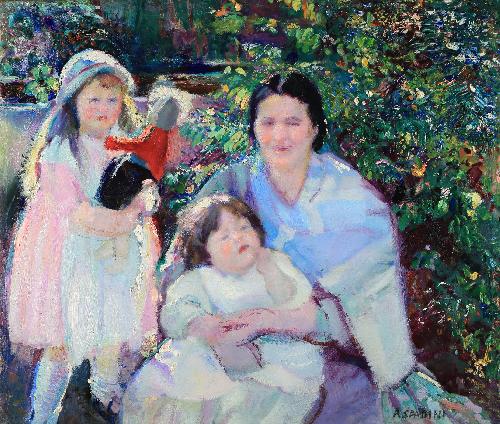SPADINI ARMANDO
POGGIO A CAIANO (FLORENCE) 1883 - ROME 1925
Born in Poggio a Cajano (Florence) on 29 July 1883, died in Rome on 31 May 1925. He studied a little at the Florentine Institute of Fine Arts, and a lot on his own, visiting museums and exhibitions, and assimilating, with his sensitive soul, the full joy of color, which is expressed differently, but not opposite, from the Venetians to the French. And precisely this great love for festive color, for transparent clarity, for solar luminosity, is in all of his work, without the tormenting research that characterizes the painting of almost everyone, even the best, impressionists. His painting is open, laughing, and summarizing; impressionist, really, not by will, but by instinct. He is a painter superior to his time and to his environment, important because he lived and worked in a moment of synthesis of the 19th century and of the opening of the following century. "He has life that nourishes his painting - writes Enrico Somare - a rich and intimate vision, which lyrically embraces the things and people familiar to his heart and his gaze, the usual aspects of domestic intimacy, translating into a series of abundant representations and compositions, perhaps a little uniform and monochromatic, but smiling with frank painting ». Lo Spadini lived in Florence until 1910; won in that year the competition for the national pensioner for painting, he settled in Rome, where he remained until his death, always painting. He participated, but not much, in the various Roman and Florentine exhibitions, and, in the summer of 1918, he held a personal exhibition at the Casina Valadier in Rome; in 1924 at the Venice Biennale he had a personal room, where he exhibited, among others, the following works: Bovi; The three ages; Mrs. Spadini in the garden; Chanterelle; Moses found; Avenue of Villa Borghese; Lillo asleep; Andrea with the cat; Landscape; Portrait of little Mary; Tree; Portrait of the painter and his wife. Many other works by him are in state and private galleries in Italy; some in Paris, in Buenos Aires, in Lima in Peru. Among the most important are: Portrait of the mother (1906); Portrait of his daughter Maria; Little girl among the flowers (1914); Children in the sun (1915); Morning (1918); Anna reading (1918), all belonging to the lawyer. Emanuele Piano of Rome; Torso of a Woman (1909), owned by Alberto Figueroa of Buenos Aires; The book (1912); Mother and child (1913); Village; The book; Portrait of Signora Signorelli with her daughter; The rattle; The garden of the lake; The self-portrait; In Villa Borghese (1913), belonging to Dr. Angelo Signorelli of Rome. Boys who study (1918); Small fishermen (1922) and Portrait of his wife, belonging to the lawyer Renato Gualino of Turin; Portrait of the fiancee, in the collection of the grand'uff. Ambrogio Molteni of Milan; Trees in spring and country, in the collection of the lawyer. Ghi-glione in Milan; Children and fish; Children and flowers; The coffee pot, in the collection of sen. Olindo Malagodi in Rome; The family of the painter De Carolis and Infant in the cradle, located in the Gallery of Modern Art «Ricci-Oddi» of Piacenza.

